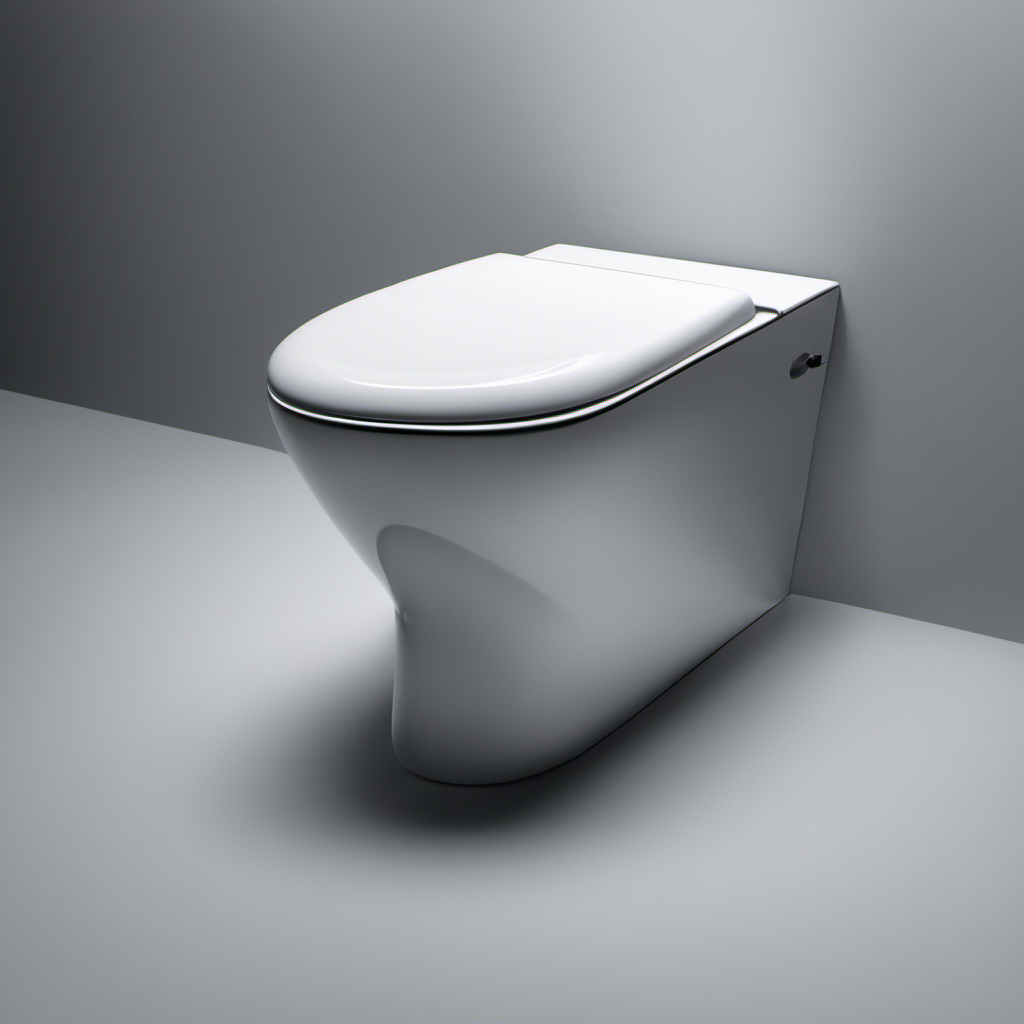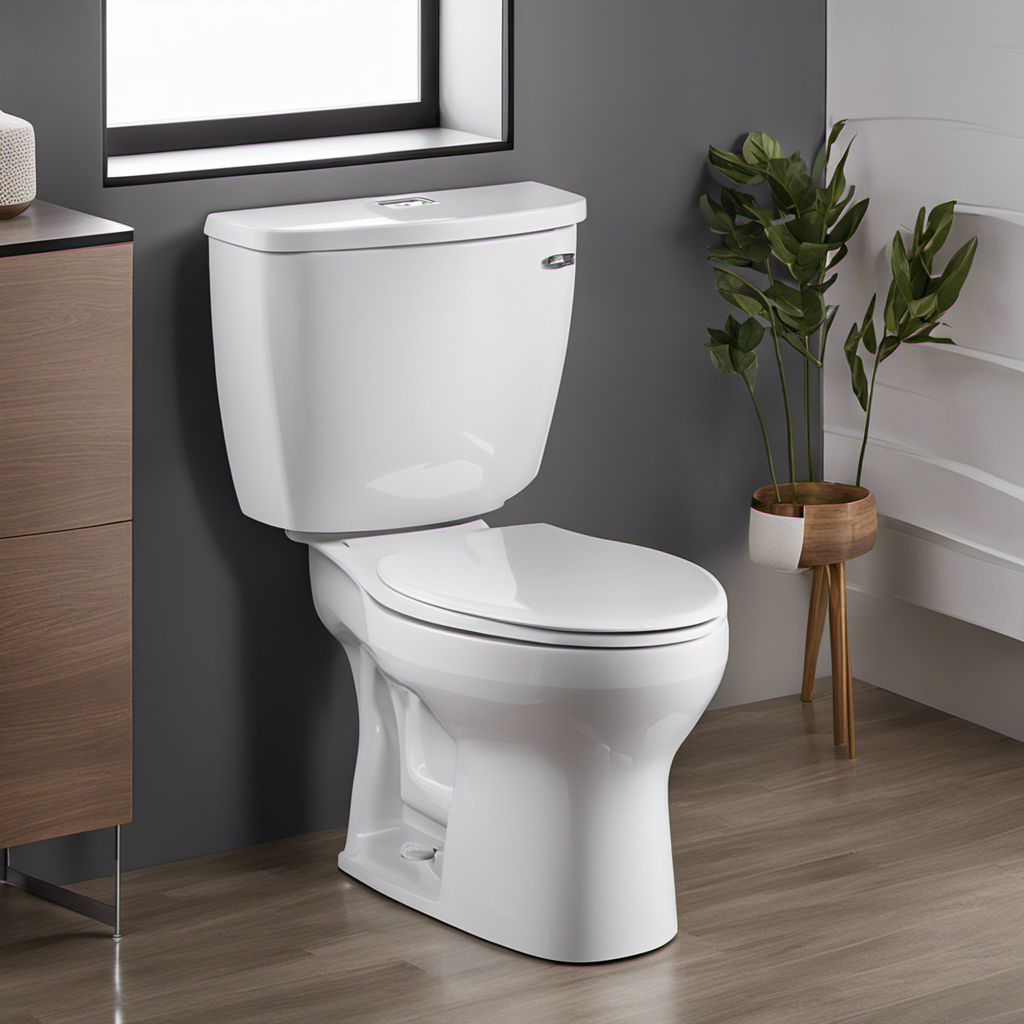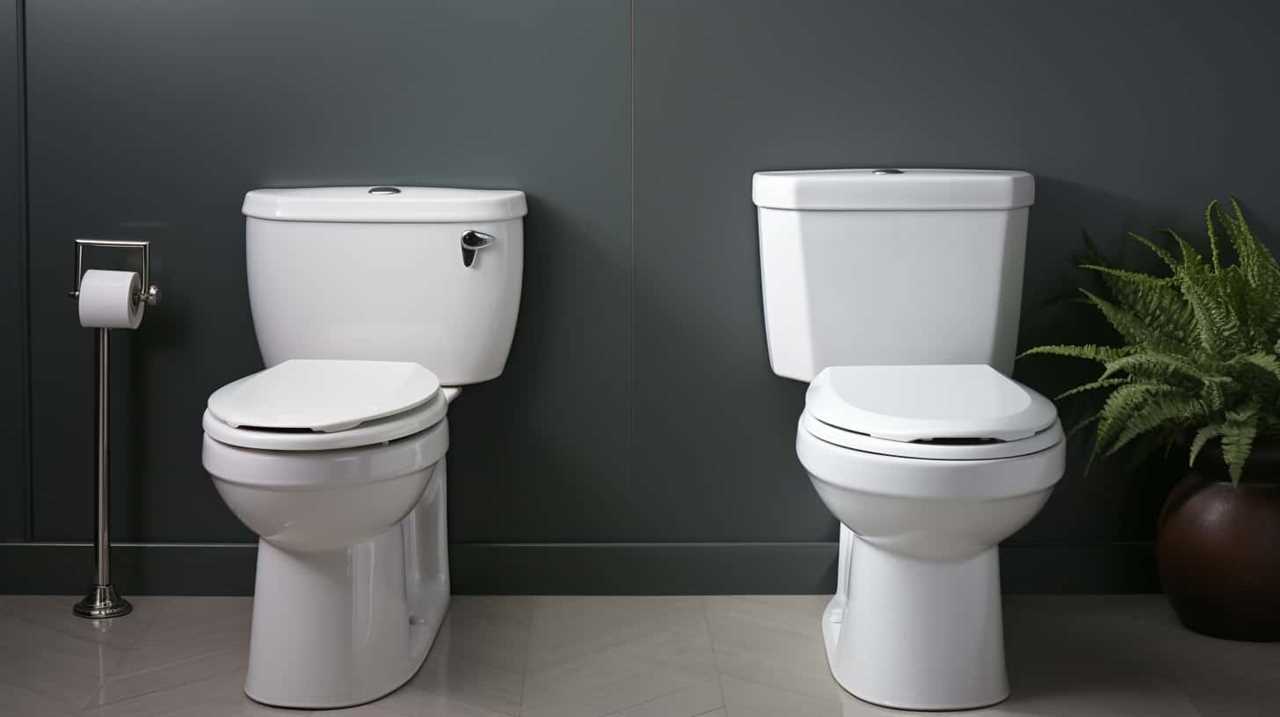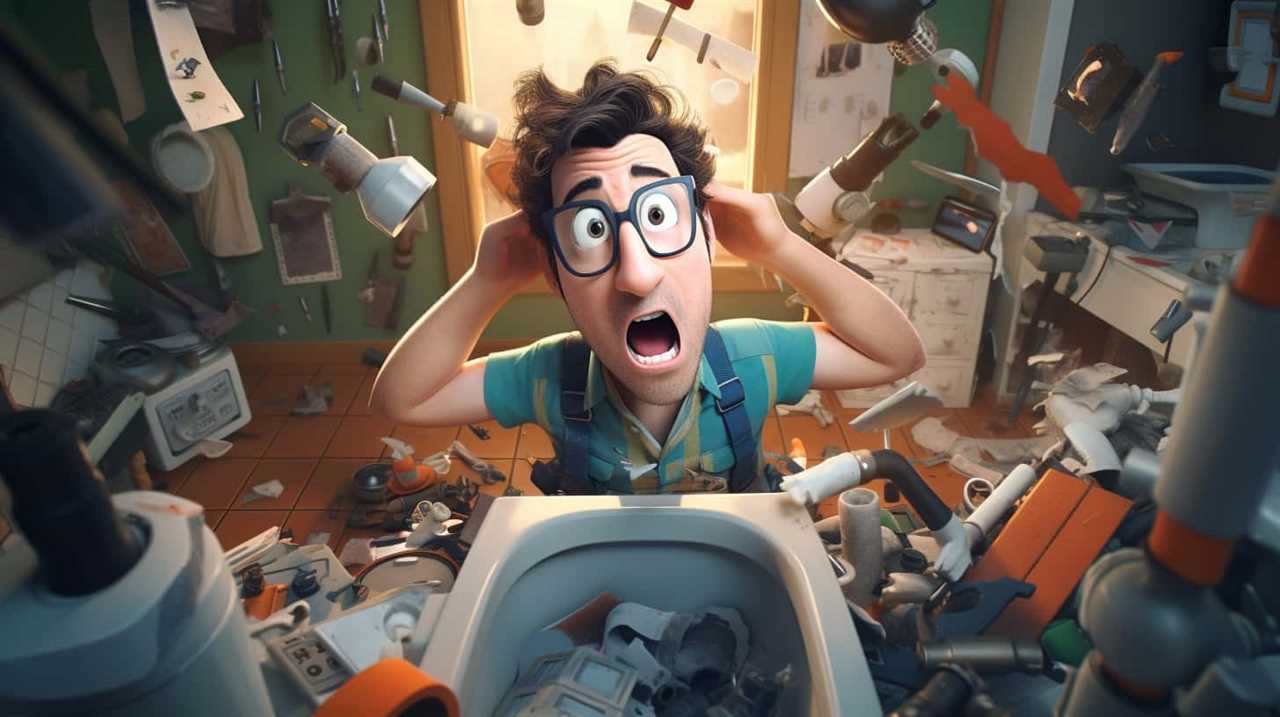Do you ever wonder how long your toilet should take to fill? Understanding the factors that affect the fill time is crucial in determining whether your toilet is functioning properly. In this article, we will explore the average time for toilet tank refill, how to identify if the fill time is normal, and troubleshooting tips for slow fill.
Furthermore, we will delve into increasing fill speed, the role of water pressure, and signs of a faulty fill valve. Get ready to become a toilet fill expert!
Key Takeaways
- There are several factors that can affect the time it takes for a toilet to fill, including water supply pressure, the size of the flush valve, the condition of the fill valve, and the design and mechanics of the toilet.
- Slow refill causes can include clogged or restricted fill valves, low water pressure, faulty float valves, and malfunctioning flapper valves.
- It is important to have an efficient water usage in toilets, and optimal refill time can help achieve that goal.
- To fix slow refill issues, one can inspect the fill valve for clogs or debris, check the float valve for proper functioning, examine the flapper valve for cracks or leaks, adjust the water level with the fill valve adjustment screw, and clean mineral deposits from the fill valve and float valve.
Factors Affecting Toilet Fill Time
There are several factors that can affect how long your toilet takes to fill.
One of the key factors influencing fill time is the water supply pressure. The pressure of the water entering your toilet tank determines how quickly it can fill up. If the water supply pressure is low, it will take longer for the tank to fill. On the other hand, if the water supply pressure is high, the tank will fill up more quickly.
It is important to note that the impact of water supply pressure on fill time can vary depending on the specific design and mechanics of your toilet.
Additionally, other factors such as the size of the flush valve and the condition of the fill valve can also play a role in determining how long it takes for your toilet to fill.
Average Time for Toilet Tank Refill
When it comes to toilet tank refill time, it is important to understand what the optimal duration should be. Factors such as the size of the tank and the water pressure can affect how long it takes for the tank to refill after flushing.
Slow refill times can be caused by various factors such as a faulty fill valve or a clogged water supply line, but fortunately, there are ways to fix this issue and improve the refill time of your toilet tank.
Optimal Refill Time
To achieve the optimal refill time for your toilet, you should adjust the water flow rate. The optimal refill time refers to the time it takes for the toilet tank to reach the optimal water level after a flush. It is an important aspect of toilet performance as it ensures efficient water usage and prevents any issues with the flushing mechanism.
By adjusting the water flow rate, you can control the speed at which the tank refills, ensuring it fills up to the correct level within the desired timeframe. However, if your toilet takes longer than usual to refill, it may be due to certain factors that cause slow refill.
Let’s explore these causes in the next section.
Causes of Slow Refill
One possible cause of a slow refill in your toilet could be a clogged or restricted fill valve. When the fill valve is clogged or restricted, it hinders the flow of water into the tank, resulting in a longer refill time.
Other factors that can contribute to a slow refill include low water pressure, a faulty float valve, or a malfunctioning flapper valve.
To troubleshoot a slow refill, start by checking the fill valve for any debris or blockages. If necessary, clean or replace the fill valve to ensure proper water flow.
Additionally, inspect the float valve and flapper valve for any signs of damage or wear. Adjust or replace these components as needed.
Fixing Refill Time
Fixing the refill time of a toilet can be done by checking for blockages or damage in the fill valve, float valve, and flapper valve. To increase refill speed and adjust the water level, follow these steps:
- Inspect the fill valve for any clogs or debris.
- Ensure the float valve is functioning properly and not sticking.
- Check the flapper valve for cracks or leaks.
- Adjust the water level by turning the adjustment screw on the fill valve.
- Clean the fill valve and float valve to remove any mineral deposits.
By following these steps, you can improve the refill time of your toilet and ensure it fills efficiently.
Once you have fixed any issues, you can then move on to determining if the toilet’s fill time is normal.
How to Determine if Toilet Fill Time Is Normal
When determining if your toilet fill time is normal, there are a few key points to consider.
Firstly, you should be aware of what the normal fill time range is for toilets in general. Factors such as water pressure, the size of the fill valve, and any potential blockages in the supply line can all affect the fill time.
If you find that your toilet is taking longer than usual to fill, troubleshooting slow fill can help identify and address any underlying issues.
Normal Fill Time
To determine the normal fill time for your toilet, you can simply observe how long it takes for the tank to refill after flushing. Factors affecting efficiency and the impact of water supply play a crucial role in determining the normal fill time. Here are some key points to consider:
- Water pressure: Higher water pressure allows for faster tank filling.
- Fill valve performance: A faulty or worn-out fill valve can lead to slower fill times.
- Supply line diameter: A larger diameter supply line allows for faster water flow.
- Plumbing issues: Clogged pipes or restrictions in the plumbing system can slow down the fill time.
- Water supply restrictions: Certain areas may have regulations or limitations on water flow, impacting the fill time.
Factors Affecting Fill Time
Now that you understand the normal fill time for a toilet, let’s explore the factors that can affect it.
Several elements can influence the flow of water and subsequently impact the time it takes for your toilet tank to fill. The first factor is the water pressure in your plumbing system. Higher water pressure results in faster fill times, while lower pressure will slow it down.
Another crucial factor is the condition of the fill valve and the supply line. If either of these components is old or damaged, it can restrict water flow and increase fill time.
Additionally, any obstructions or clogs in the supply line can impede water flow, leading to longer fill times. Therefore, it is essential to ensure proper maintenance and address any issues to optimize your toilet’s fill time.
Troubleshooting Slow Fill
If you’re experiencing a slow fill, it might be due to a clogged supply line. Here are some common toilet fill problems you can troubleshoot:
- Clogged Supply Line: Check if the supply line is blocked by debris or mineral buildup.
- Faulty Fill Valve: Inspect the fill valve for any leaks, cracks, or malfunctions that could impede water flow.
- Low Water Pressure: Ensure that the water pressure in your home is adequate for proper toilet filling.
- Partially Closed Shut-Off Valve: Confirm that the shut-off valve supplying water to the toilet is fully open.
- Incorrect Tank Water Level: Adjust the water level in the tank to the recommended mark to optimize fill speed.
Troubleshooting Slow Toilet Fill
You might want to check if the water supply valve is fully open to troubleshoot a slow toilet fill. If the valve is not fully open, it can restrict water flow, resulting in a slow fill. To increase water flow, turn the valve clockwise until it is fully open.
Another possible cause of a slow toilet fill is an incorrect water level adjustment. The water level in the toilet tank should be set to the appropriate level, typically marked on the inside of the tank. If the water level is too low, it can affect the fill speed. To adjust the water level, locate the float adjustment screw or rod and adjust it accordingly.
Increasing Toilet Fill Speed
To increase the speed at which the toilet fills, make sure the water supply valve is fully open. This will allow maximum water flow into the tank, reducing the time it takes to fill.
In addition to this, there are several other methods you can employ to increase efficiency and reduce water consumption:
-
Check for any leaks in the toilet tank or bowl. Leaks can waste a significant amount of water and slow down the filling process.
-
Consider installing a fill valve with a higher flow rate. This will allow more water to enter the tank in a shorter amount of time.
-
Clean the flush valve and the flapper. Accumulated debris can obstruct the flow of water and cause slower filling.
-
Adjust the float level in the tank. A lower float level will result in more water entering the tank, increasing the fill speed.
-
If your toilet has a water-saving feature, make sure it is properly adjusted or consider upgrading to a more efficient model.
Understanding the Role of Water Pressure in Toilet Fill Time
Now that you understand how to increase the speed at which your toilet fills, it’s important to delve into the role of water pressure in toilet fill time.
Water pressure plays a crucial role in the performance of your toilet. When the water pressure is low, it takes longer for the tank to refill after a flush. This can lead to delays in using the toilet again and frustration.
On the other hand, high water pressure can cause loud noises and even damage to your toilet’s internal components.
To ensure optimal toilet performance, it is recommended to have a water pressure of around 50-60 pounds per square inch (psi). This will provide sufficient water flow to quickly fill the tank without causing any issues.
Signs of a Faulty Toilet Fill Valve
When the water pressure is too low or too high, it can indicate a faulty toilet fill valve. It is important to properly maintain your toilet fill valve to ensure optimal performance and prevent any issues.
Here are some signs to look out for that may indicate a faulty toilet fill valve:
- Constant running water in the toilet tank
- Slow or incomplete filling of the toilet tank
- Water leakage around the base of the toilet
- Inconsistent water levels in the toilet bowl
- Difficulty flushing or weak flush
To troubleshoot toilet fill issues, you can try adjusting the water level in the tank, cleaning the fill valve, or replacing the fill valve if necessary.
Regular toilet fill valve maintenance is essential to keep your toilet functioning properly and prevent any water wastage or damage to your bathroom.
Conclusion
In conclusion, the time it takes for a toilet to fill can vary based on several factors. These factors include water pressure and the condition of the fill valve. On average, a toilet tank should take about 1-2 minutes to refill after a flush. If your toilet is taking longer than this, it may indicate a problem that needs troubleshooting.
By understanding the role of water pressure and learning how to increase fill speed, you can ensure a smooth and efficient toilet fill. Remember, a well-functioning toilet fill is like a swift river flowing into a calm lake.










